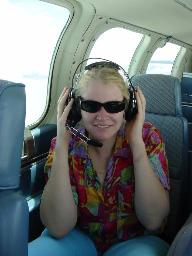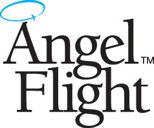
 While Rebecca was allegedly looking after Mitchell in the back:
While Rebecca was allegedly looking after Mitchell in the back:


This mission was a follow up to Angel Flight mission 37 previously flown by me in December 2003. The patient in this instance was the twin brother of the patient from last time: Now 1 year old Alister Keene, who was due to undergo surgery for hyposadiasis on the following day. While in town and recovering from this operation his brother Mitchell would also go and see his cardiologists for further check-ups.
Another pilot had been assigned this mission, but due to weather (he does not have an Instrument Rating) that pilot had to decline on the day before the mission was due to be flown. So,being the holder of an Instrument Rating, I was asked on the Tuesday lunch time whether I could do the flight in his stead. After uhmming and aaahing for about 2 seconds I happily accepted the challenge.
My previous travel companion, Rob, unfortunately could not come along again at such short notice. But Earth Angel Brian Whitbourne was successfully roped in, with Peter Riachi from Angel Flight tactically failing to mention the projectile vomiting episode from the previous flight.
Slightly worried I went to bed at 11pm and on waking at 1:30am did another check of the weather. New forecasts had now been issued and the weather, while only slightly above alternate requirements, was good enough to allow the flight to proceed.
Having had some kip, I got up at 5:30, was collected by Brian at 6:00 and we headed off to the airport to check out the plane (count the number of wings, kick the tires and check for the presence of a propeller).
Because the weather forecast for Thargomindah was non-existent, I had to refuel in Charleville on the assumption that I would need the additional fuel to return to Charleville or divert to Cunnamulla, should I be unable to get visual at Thargomindah.
The forecast for Charleville was atrociousAveral SPECI forecasts, one sounding worse than the next, were passed onto other pilots ahead of us. Despite this, each of them made successful instrument approaches, which was encouraging.
When we finally arrived overhead Charleville at the Minimum Sector Altitude of some 3000', we were relieved to see the aerodrome revealed in a large break in the clouds. A quick descend with an additional orbit to lose height, had us lined up and landing at Charleville without further ado.
Much to our dismay, we discovered that the radio did not appear to work. It only produced silence, despite my repeated calls to Flight Watch. A cross-check with Flight Service on VHF established that Flight Service had heard our calls. So while it was encouraging to know one could be heard, this was not good enough - as far the regulations were concerned we did not have the required working HF radio.
So I was forced to make a decision:
By the time we reached Thargomindah there were only a few clouds in the sky and a visual approach and landing could be easily affected. The circuit to land had us fly over the hamlet of Thargomindah, which was Rebecca's cue to drive out to the airport.
The plane was refueled and the engine allowed to cool down, while the passengers and their luggage were loaded on board.
Included in the luggage was a present from Rebecca to me: A bottle of fabric freshener to take care of the smell left over from the Mitchell's previous flight in the plane.
 After a 1:00pm departure, Brian was looking after Allister in the front:
After a 1:00pm departure, Brian was looking after Allister in the front:

 While Rebecca was allegedly looking after Mitchell in the back:
While Rebecca was allegedly looking after Mitchell in the back:
 The inflight conditions were a lot better than anticipated, with me having decided to climb as high as possible, 9000', to avoid any turbulence
from the ground convection and the cloud layer at about 7000'. So only during their climb up did we encounter a few minor bumps:
The inflight conditions were a lot better than anticipated, with me having decided to climb as high as possible, 9000', to avoid any turbulence
from the ground convection and the cloud layer at about 7000'. So only during their climb up did we encounter a few minor bumps:

 The boys slept most of the way, waking up occasionally to have a skeptical look at the ugly fella in the pilot's seat, and getting some sustenance:
The boys slept most of the way, waking up occasionally to have a skeptical look at the ugly fella in the pilot's seat, and getting some sustenance:
 Eventually we re-entered the cloud and spent most of the rest of the flight with a view similar to this:
Eventually we re-entered the cloud and spent most of the rest of the flight with a view similar to this:

 I now needed a sugar boost as well, and comparing these pictures one has to wonder which one of these two blokes was in charge here:
I now needed a sugar boost as well, and comparing these pictures one has to wonder which one of these two blokes was in charge here:
 On and off the boys did go back to sleep:
On and off the boys did go back to sleep:
Air traffic control, upon being told that there were two infants on board and being requested for as gentle a descend profile as possible, were most obliging, guiding us safely to Archerfield where an uneventful landing had us taxi back to the parking bay at 4:30pm.
While we were airborne on this mission, Queensland experienced some of the worst flooding in several years, as The Courier Mail reports.